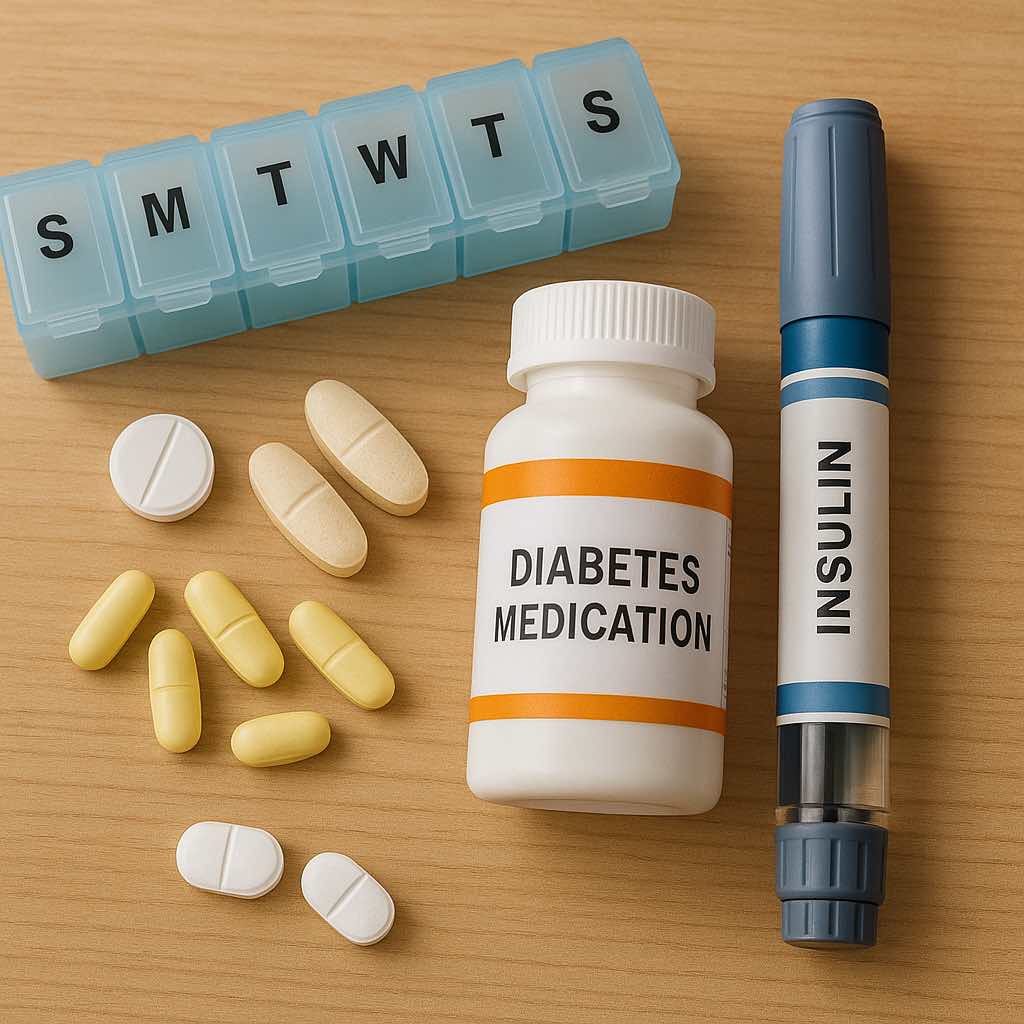Understanding your diabetes medications is an essential part of managing your condition effectively. Whether you’re newly diagnosed or have been living with diabetes for years, this guide will help you understand how different medications work and how to use them properly.
The Role of Medication in Diabetes Management
While healthy eating, regular physical activity, and weight management are foundational to diabetes care, many people also need medication to keep their blood sugar within target ranges. Medications work alongside lifestyle measures—not as a replacement for them.
The type of medication you need depends on several factors:
- The type of diabetes you have
- How long you’ve had diabetes
- Your current blood sugar levels
- Other health conditions you may have
- How your body responds to different treatments
Common Types of Diabetes Medications
For Type 1 Diabetes
Insulin: People with Type 1 diabetes must take insulin because their bodies don’t produce it. Insulin cannot be taken as a pill because stomach enzymes would break it down before it could work.
Types of insulin include:
- Rapid-acting insulin: Begins working within 15 minutes, peaks in about 1 hour, and continues working for 2-4 hours
- Short-acting insulin: Starts working within 30 minutes, peaks in 2-3 hours, and is effective for 3-6 hours
- Intermediate-acting insulin: Begins working within 2-4 hours, peaks in 4-12 hours, and is effective for 12-18 hours
- Long-acting insulin: Starts working several hours after injection and lowers glucose levels fairly evenly over a 24-hour period
For Type 2 Diabetes
People with Type 2 diabetes may take various oral or injectable medications, sometimes including insulin. Common classes include:
Metformin: Usually the first medication prescribed for Type 2 diabetes. It works by:
- Reducing the amount of glucose your liver releases
- Improving how your body responds to insulin
- Causing few low blood sugar episodes when used alone
Sulfonylureas: These medications help your pancreas release more insulin. Examples include glipizide and glimepiride.
DPP-4 Inhibitors: These help your body continue to make insulin when blood sugar is high. Examples include sitagliptin and linagliptin.
SGLT2 Inhibitors: These cause your kidneys to remove sugar through your urine. Examples include empagliflozin and canagliflozin.
GLP-1 Receptor Agonists: These injectable medications slow digestion, help lower blood sugar, and may support weight loss. Examples include semaglutide and dulaglutide.
Thiazolidinediones: These help your body’s tissues respond better to insulin. Examples include pioglitazone and rosiglitazone.
Insulin: Some people with Type 2 diabetes need insulin, either temporarily or permanently, especially as the condition progresses.
Taking Medications Correctly
The effectiveness of your diabetes medication depends largely on how you take it:
Follow the Prescribed Schedule: Take medications at the same times each day to maintain consistent blood sugar levels.
Never Skip Doses: Even if you feel well, continuing your medication is crucial for long-term health.
Understand Food Interactions: Some medications should be taken with food, while others work best on an empty stomach.
Know Storage Requirements: Some medications, particularly insulin, have specific storage needs to maintain effectiveness.
Learn Proper Injection Technique: If you use injectable medications, proper technique ensures you get the full benefit with minimal discomfort.
Use Pill Organizers: These can help you keep track of multiple medications and avoid missed doses.
Set Reminders: Use smartphone alarms, apps, or other reminder systems to stay on schedule.
Managing Side Effects
All medications can cause side effects, though not everyone experiences them. Common side effects of diabetes medications include:
Metformin: Digestive issues like nausea or diarrhea, usually temporary Sulfonylureas: Low blood sugar, weight gainSGLT2 Inhibitors: Urinary tract infections, yeast infectionsGLP-1 Receptor Agonists: Nausea, vomiting, diarrhea (usually improving over time) Insulin: Low blood sugar, weight gain, injection site reactions
If you experience troublesome side effects:
- Don’t stop taking your medication without consulting your healthcare provider
- Report side effects promptly
- Ask about adjusting dosage or timing
- Discuss whether a different medication might work better for you
Medication and Lifestyle Integration
Your medications work best when combined with healthy lifestyle choices:
Timing Around Meals: Some medications need to be coordinated with food intake to prevent low blood sugar.
Exercise Considerations: Physical activity can lower blood sugar, so you may need to adjust medication timing or dosage on days with increased activity.
Alcohol Interactions: Alcohol can affect blood sugar and may interact with certain diabetes medications.
Sick Day Management: Illness can affect your blood sugar levels and how your medications work.
Creating a Medication Schedule
A consistent medication routine helps maintain stable blood sugar levels:
- List all medications with dosages and timing requirements
- Align with daily routines like meals, bedtime, or morning coffee
- Use technology like smartphone apps to track medications
- Keep a backup supply of essential medications
- Develop a system for refilling prescriptions before they run out
Moving Forward
Creating a medication schedule that works with your daily routine is essential for successful diabetes management. Take time today to review your current medications, their dosages, and when you should take them. Set up a system of reminders to help you stay on track.
Remember to bring a complete list of your medications to every healthcare appointment, and don’t hesitate to ask questions about your treatment plan. Understanding your medications empowers you to take an active role in managing your diabetes and protecting your long-term health.

